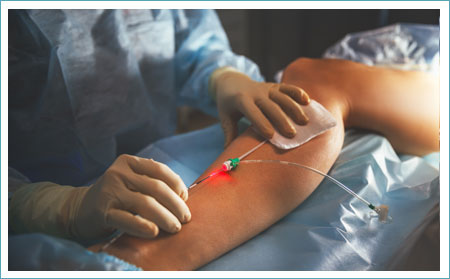Vein Conditions
Varicose and Spider Veins
 Roughly 60% of men and women deal with some form of vein disorder. For many people, varicose veins and spider veins — a common, mild variation of varicose veins — are simply a cosmetic concern. For other people, varicose veins can cause aching pain and discomfort. Sometimes varicose veins lead to more serious problems.
Roughly 60% of men and women deal with some form of vein disorder. For many people, varicose veins and spider veins — a common, mild variation of varicose veins — are simply a cosmetic concern. For other people, varicose veins can cause aching pain and discomfort. Sometimes varicose veins lead to more serious problems.
Table of Contents - click below to jump to topic
ToggleWhat Are Varicose and Spider Veins?
Varicose veins are blood vessels that become enlarged, resulting in a swollen, twisted appearance. They are dark blue or purple in color and bulge outside the skin. While varicose veins are sometimes a cosmetic issue, they can also be painful, especially for those who stand or sit for long periods of time. Occasionally they are a symptom of deeper, underlying vascular problems.
While varicose veins can appear anywhere, they typically sprout up on the legs and ankles. Spider veins, the more delicate red or blue tracings that can pop up on the skin’s surface like kinky spider webs, are a minor form of varicose veins.
What Causes Varicose and Spider Veins?
Normal, healthy veins carry blood to the heart via a circuit of valves that flow in a one-way direction. When these valves weaken, this allows backwash. Where blood flows in the wrong direction, back down into the leg and/or ankle. This backflow stretches the veins, causing symptoms like swelling, bulging, and twisting, which results in a varicose vein or veins.
Who Has Varicose Veins and Why?
While this varies from patient to patient, genetics are often the cause. Other factors include aging, obesity, prior trauma, and leg surgery. The work environment also comes into play. The condition is more prevalent in people with jobs that keep them standing for prolonged times, such as nurses, teachers, and retail workers, among others.
Why Are Women More Often Diagnosed With Varicose Veins?
Hormones also play a big part in vein health. While anyone can suffer from venous conditions, women are twice as susceptible as men, due to hormonal cycles during puberty, pregnancy, and menopause.
Venous Ulcers and Venous Insufficiency
Venous insufficiency occurs when the veins in your legs aren’t circulating blood back to the heart efficiently. When this happens, fluids can pool in the leg, which can cause varicose veins.
While venous insufficiency is often the cause of varicose veins, it can also lead to a number of other problems, including
- Aching or heaviness in the legs
- Pain, numbness, and itching
- Fatigue
For some, venous insufficiency is at the root of Restless Legs Syndrome, a condition that affects 10% of adults in the U.S.
Venous Ulcers
One of the most painful problems caused by venous insufficiency is venous ulcers. Venous ulcers present as wounds or sores on the skin of the leg, usually the skin around the ankle. A typical first line of treatment for leg ulcers focuses on healing the skin. However, an external treatment will provide only temporary relief – at best – if there are underlying issues with the veins. This is why it’s so crucial to be diagnosed by Dr. Jaimes or another Vein Specialist who can provide a thorough, expert diagnosis and treatment plan.









